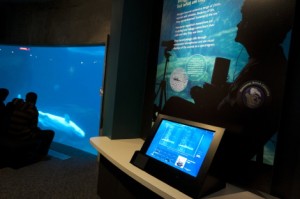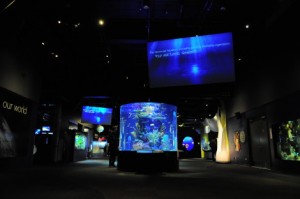Four Winds Blow Through Vancouver Aquarium
Gail Chiasson, North American Editor
When the Our World gallery officially opens tomorrow, Feb. 14, at the Vancouver Aquarium, a new video wall and screens that will add pizzazz are the latest stage in the famed aquarium’s efforts to better connect with visitors, after having installed wayfinding stations last summer.
Since its inception at Vancouver’s Stanley Park in 1956, the Vancouver Aquarium has been internationally recognized for excellence in the display and interpretation of animal in its care. It was the first facility to incorporate professional naturalists into its galleries to explain animal behavior and natural history, and it has continued to find innovative ways to fulfill its promise to amaze and inspire its visitors.That mission became more challenging in the digital age. Where visitors were once content to look at the animals on display and read a little information about them on static signs, today’s public expects more in the way information is presented.
“We’re in an increasingly connected world, and in the past few years we’ve built our galleries on the concept of being actively connected,” says Jeff Heywood, acting director of content at the Vancouver Aquarium.“It’s a modern approach taken by our president.(John Nightingale). We don’t want to build a gallery, leave it up for five or 10 years, then take it down and change it. We want our galleries to be changing constantly, so when visitors return it’s always a new experience. That’s what keeps people coming back – and bringing their friends with them.”
Personnel at the Aquarium are continuously encouraged to push past the current boundaries and expectations of a facility of its type. That is the approach Heywood and his team took when incorporating digital displays and digital communications solutions into the galleries. Their first attempt proved that digital screens could be integrated into exhibit galleries to enhance rather than detract from the animals. But as their needs grew, the existing system proved to be increasingly restrictive.
“We had a lot of ideas as to what we wanted to do, but we didn’t have a great way of doing them,” Heywood says. “We needed to find a digital communication platform that offered a great deal of flexibility, while not requiring the operator to be a technology expert. It had to allow us to incorporate text, video, wayfinding, interactivity and things we hadn’t even thought of yet, so that even the most jaded, tech-savvy visitors in our galleries can get a jaw-dropping experience and say ‘wow!’”
Vancouver Aquarium engaged Four Winds Interactive, Denver, Colorado, to develop a custom digital communications solution. Heywood chose FWi because of the breadth of capabilities of its software, the flexibility it offered and its ease of use.“We needed a solution that would allow us to be creative, play with some ideas, see which ones worked and which ones didn’t, and then build on our successes,” Heywood says. “FWi made it easy to do that. Rather than having multiple screens delivering the same type of information, we’re able to do innovative and creative things, either within a gallery or sometimes even on the same screen. It really enhances the visitor experience.”
The Arctic Gallery, eg., features several screens that present a lot of different content, such as Arctic issues, climate issues, territorial issues and little-known information about sea ice and Arctic animals. Additionally the gallery has a large 46” touch screen that provides a wide variety of helpful information to visitors.
“That screen takes advantage of the whole button structure that’s part of the FWi back end,” says Heywood. “It has an interactive map that’s tied to our central scheduling database. As the schedule updates, visitors can see that there is a show coming up soon in the Amazon Gallery. If they push the ‘Map It’ button, the screen will show them the fastest route to get there, which is important since our building has a lot of twists and turns. It also runs video that highlights future promotions or conservation programs, such as Ocean Wise, The Great Canadian Shoreline Cleanup or other seasonal events. We use that one display screen to do a lot.”
Move 30 feet away from the main screen and there are a number of touch panels that use FWi’s technology to host Flash video. Some are simple Flash interactive mechanisms, where you push a button to start the video, while others are heavily scripted (such as an interactive component that highlights beluga whale vocalizations.) Despite having widely different applications, they all run off the same FWi software.
There also is a large plasma screen that runs 90-second environmental news segments – stories on the Arctic and issues affecting it that will raise the visitors’ awareness. These include information about Arctic weather and temperatures. That screen also includes a live polar bear feed via a webcam from Churchill, Manitoba – a partnership between Vancouver Aquarium and Explore.org.
The Aquarium is currently using FWi to manage 25 screens throughout the more than 100,000 sq. ft. facility. Its remaining old screens will be converted to FWi in the near future, bringing the total to more than 50 screens that will be scheduled by one person and maintained by one other. Given that the Aquarium is a non-profit organization with limited funding, managing the process with so few resources is critical to its success.
“The ability for FWi to point to a database outside its system – in our case Sharepoint – and draw information from it is very important,” Heywood says. “We can enter the data once and use it wherever we need it. I like being able to use calendar-based scheduling, so if I want to work on something in December and have it appear on January 4 between 1:00 and 3:00 PM, I can do it. It’s a very well thought-out system.”
The content management system has been a huge time-saver. The Aquarium has between 500 and 1,000 items in its library that can be programmed and of them can be assigned to any screen simply by dragging and dropping. (The FWi system doesn’t rely on proprietary hardware or software.)
“With FWi, we use general PCs running Windows 7 that we can source as-needed,” says Heywood.
Plans are now in the works to add the ability for Aquarium employees, such as interpreters, to take control of any screen from an iPad to point out certain information, such as a behavior of a particular animal. The intent is to build better connections with visitors and help them to get more out of their experiences. And down the road, the Vancouver Aquarium may look into giving visitors limited control of the screens from their own iPads or smartphones.
“Everyone is walking around with little computers, so giving them more control over what they’re seeing is a natural next step,” Heywood says. “It will let them tailor their experience to their personal tastes, and give them more reasons to spend more time and come more often.”



Follow DailyDOOH